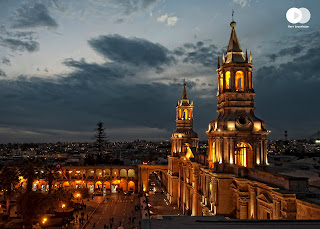Arequipa: Peru's White City at the Foot of the Andes
Arequipa, Peru’s second-largest city, is nestled at the foot of the Misti Volcano. Founded in 1540 by Spanish conquistadors, it blends colonial architecture with indigenous influences. The city’s historic center, built from white volcanic sillar stone, earned it the nickname “White City” and a UNESCO World Heritage status. Arequipa played a vital role during Peru’s fight for independence and remains a cultural hub, known for its vibrant traditions, rich cuisine, and historic monasteries, such as the Santa Catalina Monastery. The dramatic Andean landscape surrounding Arequipa adds to its allure, making it a significant destination in southern Peru.
秘魯第二大城市阿雷基帕依偎在米斯蒂火山的腳下。這座城市由西班牙殖民者於1540年建立,將殖民時期的建築與原住民的影響完美融合。阿雷基帕的歷史中心由白色的火山矽石建造,為其贏得了「白色之城」的美譽,並被聯合國教科文組織列為世界遺產。在秘魯爭取獨立的過程中,阿雷基帕扮演了至關重要的角色,如今仍是一個文化中心,以其充滿活力的傳統、豐富的美食和歷史悠久的修道院(如聖卡塔利娜修道院)而聞名。阿雷基帕周圍壯觀的安第斯山脈景觀增添了它的魅力,使其成為秘魯南部的重要目的地。
Arequipa, die zweitgrößte Stadt Perus, liegt eingebettet am Fuße des Vulkans Misti. Gegründet im Jahr 1540 von spanischen Konquistadoren, verbindet sie koloniale Architektur mit indigenen Einflüssen. Das historische Zentrum der Stadt, erbaut aus weißem Vulkangestein namens Sillar, brachte ihr den Spitznamen “Weiße Stadt” und den Status eines UNESCO-Weltkulturerbes ein. Arequipa spielte eine entscheidende Rolle im peruanischen Unabhängigkeitskampf und bleibt ein kulturelles Zentrum, bekannt für seine lebendigen Traditionen, seine reiche Küche und historische Klöster wie das Kloster Santa Catalina. Die dramatische Andenlandschaft, die Arequipa umgibt, trägt zu ihrer Anziehungskraft bei und macht sie zu einem bedeutenden Reiseziel in Südperu.



Comments
Post a Comment